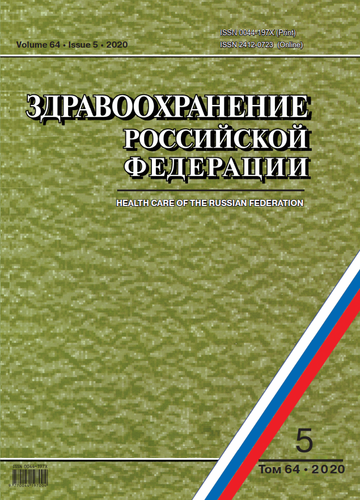Organizing experience in an epidemiological service in the context of urgent conversion of a general hospital to manage patients with SARS-CoV-2 infection
- Authors: Vechorko V.I.1, Gorbacheva V.A.1, Kostenko O.A.1
-
Affiliations:
- Municipal Clinical Hospital № 15 named after O.M. Filatov
- Issue: Vol 64, No 5 (2020)
- Pages: 230-235
- Section: HEALTH CARE ORGANIZATION
- Submitted: 25.10.2024
- URL: https://rjonco.com/0044-197X/article/view/637914
- DOI: https://doi.org/10.46563/0044-197X-2020-64-5-230-235
- ID: 637914
Cite item
Full Text
Abstract
February 11, 2020, World Health Organization (WHO) declared a pandemic of the new coronavirus and assigned the official name of the infection caused by the new coronavirus - COVID-19 («Coronavirus disease 2019»). On February 11, 2020, the International Committee on Virus Taxonomy gave the official name to the infectious agent as SARS-CoV-2. A new coronavirus infection caused by SARS-CoV-2 has become a challenge for the healthcare system as in Russia as over the world. The medical community has focused its efforts on fighting the pandemic. On March 20, 2020, there the O. M. Filatov Municipal clinical hospital was decided to be redesigned, and this general hospital, including maternity wards, became an infection hospital. One of the main reasons for redesigning was multidisciplinary medical care, including working with patients with a new coronavirus infection, the presence of a maternity home with boxes and own reanimation, the presence of a transition connecting for all three buildings, a large area, with ability to organize routes and placements additional temporary buildings. In the first place there were solved problems as a device of sanitary systems with the gateway, division to the «red» and «green» zones in all buildings of the clinics, development of detailed routing the patients including infectious requirements, navigation inside buildings and on hospital territories for the separation of medical personal, transport, the realization of a plan with the requirements, submitted by Federal Service for Oversight of Consumer Protection and Welfare to medical institutions, working with a new coronavirus infection, in terms of sanitary standards: disinfection of areas and surfaces and transport, creation inventory curative diagnostic (including reanimation) equipment, sufficient number of oxygen points, medicines, disinfection products and personal protective equipment. One of the scale tasks were about care for the health safety of medical personal. Changes to the work concerned various aspects: legal regulation, ethical problems, features practical work and education, interaction with all of them structural departments of the hospital. Within a week task, which put the Department of health of the city of Moscow, was resolved by management of hospital, and on March 27, 2020, the hospital accepted the first patients as an infectious disease hospital.
About the authors
Valery I. Vechorko
Municipal Clinical Hospital № 15 named after O.M. Filatov
Author for correspondence.
Email: noemail@neicon.ru
ORCID iD: 0000-0003-3568-5065
Russian Federation
Viktoriya A. Gorbacheva
Municipal Clinical Hospital № 15 named after O.M. Filatov
Email: vikgorbacheva@mail.ru
MD, Deputy Chief Doctor, Municipal Clinical Hospital № 15 named after O.M. Filatov, Moscow, 111539, Russia.
e-mail: vikgorbacheva@mail.ru
Russian FederationOxana A. Kostenko
Municipal Clinical Hospital № 15 named after O.M. Filatov
Email: noemail@neicon.ru
Russian Federation
References
- Zuev V.A. The Many Faces of the Virus. Secrets of Hidden Infections [Mnogolikiy virus. Tayny skrytykh infektsiy]. Moscow; 2012: 11–3. (in Russian)
- Baltimore D. Expression of animal virus genomes. Bacteriol. Rev. 1971; 35(3): 235–41.
- L’vov D.K., ed. Virology Guide. Viruses and Viral Infections of Humans and Animals [Rukovodstvo po virusologii. Virusy i virusnye infektsii cheloveka i zhivotnykh]. Moscow; 2013. (in Russian)
- Tyrrell D.A.J., Bynoe M.L. Cultivation of a novel type of common-cold virus in organ cultures. Br. Med. J. 1965; 1(5448): 1467–70. https://doi.org/10.1136/bmj.1.5448.1467
- Almeida J.D., Berry D.M., Cunningham C.H., Tyrrell D.A.J. Virology: coronaviruses. Nature. 1968; 220(650-650): 213.
- Gu J., Han B., Wang J. COVID-19: Gastrointestinal manifestations and potential fecal-oral transmission. Gastroenterology. 2020; 158(6): 1518–9. https://doi.org/10.1053/j.gastro.2020.02.054
- Kampf G., Todt D., Pfaender S., Steinmann E. Persistence of coronaviruses on inanimate surfaces and their inactivation with biocidal agents. J. Hosp. Infect. 2020; 104(3): 246–51. https://doi.org/10.1016/j.jhin.2020.01.022
- WHO. Novel Coronavirus – China. Disease outbreak news; 2020. Available at: https://www.who.int/csr/don/12-january-2020-novel-coronavirus-china/en/
- WHO. Infection prevention and control during health care for probable or confirmed cases of coronavirus (COVID-19) infection: interim guidance. Available at: https://www.who.int/publications/i/item/infection-prevention-and-control-during-health-care-when-novel-coronavirus-(ncov)-infection-is-suspected-20200125
- WHO. Director-General’s opening remarks at the media briefing on COVID-19 – 3 March 2020. Available at: https://www.who.int/dg/speeches/detail/who-director-general-s-opening-remarks-at-the-media-briefing-on-covid-19---3-march-2020
- Bassetti M., Vena A., Giacobbe D.R. The novel Chinese coronavirus (2019-nCoV) infections: Challenges for fighting the storm. Eur. J. Clin. Invest. 2020; 50(3): e13209. https://doi.org/10.1111/eci.13209
Supplementary files










